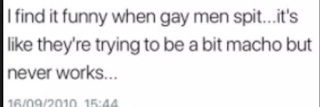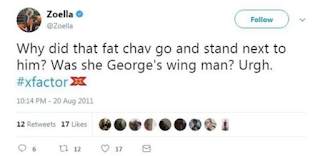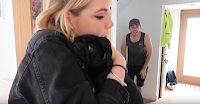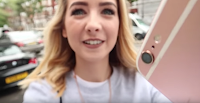Targets gay British men
Attitude is owned and published by Stream - horizontally integrated
- covering the period July –Dec 2014. Attitude digital has 12,701 readers which is a year on year growth of 27.4%
- Main imagine is stereotypical of a homosexual man, with the posed face and the bow tie and also the mise-en-scene of the umbrella- he's stereotypical attractive for a homosexual audience- he's staring out of the photograph
- The basic colour scheme of white background and small coloured accents connotes to the LGBT flag
- Anchorage of the title juxtaposes the stereotypical confidence of a homosexual man, and also makes him more feminine
- San serif font is very simple and bold, and makes it easy to read and understand
- Use of green folio (category) helps reader understand which section of the site they're on
- The target gay British audience would know about the West-end and the audience being predominately gay
- The hash tag '#queerAF podcast' - intertextuality- assumes that the audience is interested in that side of the article
- Targeted to a younger audience through the use of a hashtag and also that they call it a 'student' podcast
- Labelling themselves 'queer' is a example of re-appropriation
- Mise-en-scene connotes old school musicals such as singing in the rain


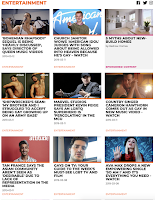
- Article with male models is provocative poses is voyeuristic
- The promotion of holidays, cruises and gyms all use disposable income which stereotypically homosexual men have as they don't have children to pay for
- Gay icon of Freddie Mercury and also speaking of the film 'Bohemian Rhapsody' related to the way that they want to attract their readers and empower them
- promotion of sperm-enhancing drugs is very specific to the target, with the colour pink on the packaging connoting to femininity
- Very stereotypically gay with the articles and mise-en-scene which makes gay people feel inclusive and they're part of a community
bell hooks theory is vital here- 'feminism is for everybody'
How are Gay men represented in Attitude online?
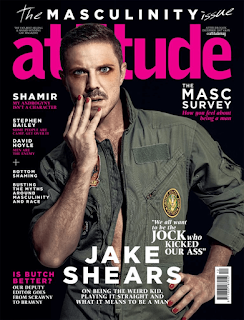
He suggests that 'the media representations play an important role in defining the ideological thinking of audiences regarding specific social groups'
- we get stereotypes because of inequality- we have a group in power and they construct stereotypes of lesser groups within society
Paul Gilroy- theories around ethnicity and post colonial theory
• Post-colonialism is the study of the impact that being under direct rule has had on former colonies. For example, despite being a tiny island, Britain colonised and declared ownership of many countries, including India and Australia.
• These ideas and attitudes continue to shape contemporary attitudes to race and ethnicity in the postcolonial era
• These postcolonial attitudes have constructed racial hierarchies in our society, where, for example, white people are by and large given more positive and important roles than BME people
• Media producers are also guilty of using binary oppositions to reinforce BME people and characters as 'others'
Vogue's inside front cover and double page spread is £157k whereas attitudes is £9kIndustry:
- professional- high up in the company, have a good job, e.g a lawyer or doctor
- The pink pound- the concept that they have higher disposable income as they are less likely to have children
- very stereotypical - easier for producers- for financial reasons audience is sold to advertisers - allows the audience to be sold
- consumerist society- media products only exist to male money
- advertising makes up a 3rd of a magazine, which is essential to keeping the cover price of magazines down.

- website launched January 2014
- possibly weren't sure if the website will be successful
-an example synergy - when two things work well together
- chose not to have a website for a long time
- website ideology differs from the magazine: the magazine is more classy, where as the website is full of adverts and looks like it is targeting a working class audience (to target a larger audience) - where as the magazine targets a middle class audience
- website looks similar to the 'daily mail online'
- attitude online isn't in competition with the print magazine (attitude)
Brand identity is the ideology of the institution (a company)
- Stream have internationalised there busy through partnering with Vauxhall
An example of multisector and multimedia integration is attitude online and the magazine
Pick and Mix theory: theories around identity:
-Within 'attitude online' gay men can use this theory through the 'style' section of the website e.g through the article "This week's hottest clothes and accessories"
- They'd then look at this section of the website to form how they want too look and by having such a high focus on fashion (high end products) they are selling a very expensive lifestyle
- Makes the assumption that the gay audience is very flamboyant and image obsessed- reinforces a stereotype (makes targeting an audience easier as they've constructed the audience)
- there is a focus on gay icons
-'Gay icons' are named such as they are people who are bold, confident and comfortable in their own skin which may gay people aspire to- also in the opinions section they discuss gay icons which displays that gay people should form their identity due to certain celebrities
Attitude is covering an extremely complex issue in a very simple way
They use multiple social media platforms to target a larger audience
Clay Shirky- The end of audience theory:
Attitude give its audience very little chance to interact with it
The magazine has a letters page
How are Gay men represented in Attitude online?
- Hyper-sexualised images of men are frequently used within the magazine- big focus on openness and 'out-there' sexualisation- the magazine and website have a definite target audience and may go 'hidden' in general society
- Multiple articles that suggest that homosexuals are vulnerable, they also aim to give gay people more confidence refers to 'coming out'
- Conforms to the stereotypes that homosexuals are vain, there are many articles about looks- a focus on aesthetics
- Promiscuity is very prominent within the style and lifestyle arguments
- Represented as feminine as they're described as 'beautiful'
- Article on gay rugby team focusses on the team's body image as opposed to their sporting progress, again reinforcing an emphasis on aesthetics
- Represented as extravagant and with an exotic lifestyle
- Proud and self confident- gives the audience confidence to come out and to live with pride
- Singular and stereotypical representation of men - like in woman's magazine with females
- This is a very specific representation of masculinity - singular and stereotypical representation - cultivates the idea that this is what gay men should look like - its not diverse
- This may be a reaction to the stereotype that gay men are feminine
The purpose of attitude online is to promote the magazine
one of the advantages of the websites is more people can access it if they're in the closet

- What representations of masculinity are constructed in this front cover? Make explicit reference to the toolkit for textual analysis.
- To what extent does this cover subvert hegemonic representations of masculinity?
- How is anchorage provided by the cover lines of the magazine cover?
- How does the print version of Attitude demonstrate digital convergence?
- The use of hot pink connotes a stereotypically female colour
- Colour scheme looks like ann summers
- Mise-en-scene of the army outfit is stereotypically very masculine and straight men however the outfit being unzipped is very stereotypically gay
- wide, bright eyes with eye liner and eye make up is much more stereotypical of a female cover model
- The use of red nail polish is typically sexy and alluring
- Its part of the attitude brand - they have a synergistic relationship
- challenges ideas of masculinity- through the use of heavy make up , there is a binary opposition between the make up and the jacket
- his pose is camp
- He's staring at the audience
- The magazine and website have a synergistic relationship
- subversive of stereotypes
- The sell line hints at something you will get inside the magazine
Stuart Hall- stereotypes and inequality in attitude:
- we get stereotypes because of inequality- we have a group in power and they construct stereotypes of lesser groups within society
Paul Gilroy- theories around ethnicity and post colonial theory
• Post-colonialism is the study of the impact that being under direct rule has had on former colonies. For example, despite being a tiny island, Britain colonised and declared ownership of many countries, including India and Australia.
• These ideas and attitudes continue to shape contemporary attitudes to race and ethnicity in the postcolonial era
• These postcolonial attitudes have constructed racial hierarchies in our society, where, for example, white people are by and large given more positive and important roles than BME people
• Media producers are also guilty of using binary oppositions to reinforce BME people and characters as 'others'
- Postcolonial attitudes
- hierarchies
- binary oppositions
- othering
Attitude presents a very stereotypical representation of gay men
Vogue's inside front cover and double page spread is £157k whereas attitudes is £9kIndustry:
- Who publishes Attitude?
- owned by Stream Publishing Limited- attitude September 2016
- What other products does the publisher publish?
-Creates magazines for companies
- the use of 'meet the team' makes the website less serious and humanises the company/ website
- customer magazines (genre)
-stream sell advertising space
- wing they owned first then brought 'Attitude magazine" horizontal integration - eliminates the competition
- professional- high up in the company, have a good job, e.g a lawyer or doctor
- The pink pound- the concept that they have higher disposable income as they are less likely to have children
- very stereotypical - easier for producers- for financial reasons audience is sold to advertisers - allows the audience to be sold
- consumerist society- media products only exist to male money
- advertising makes up a 3rd of a magazine, which is essential to keeping the cover price of magazines down.
- website launched January 2014
- possibly weren't sure if the website will be successful
-an example synergy - when two things work well together
- chose not to have a website for a long time
- website ideology differs from the magazine: the magazine is more classy, where as the website is full of adverts and looks like it is targeting a working class audience (to target a larger audience) - where as the magazine targets a middle class audience
- website looks similar to the 'daily mail online'
- attitude online isn't in competition with the print magazine (attitude)
Brand identity is the ideology of the institution (a company)
Concentration, integration and co-opting publicity
Cultural industry companies deal with risk and the need to ensure audience maximisation by using strategies that are also apparent in other sectors.- Horizontal integration - They buy up other companies in the same sector to reduce the competition for audiences and audience time.
- Vertical integration - They buy up other companies involved in different stages of the process of production and circulation. Companies might buy ‘downstream’, such as when a company involved in making films buys a DVD distributor, or ‘upstream’, which is when a company involved in distribution or transmission (such as a cable television company) buys a programme-maker.
- Internationalisation - By buying and partnering other companies abroad, corporations can sell massive amounts of extra copies of a product they have already paid to produce (though they will have to pay new marketing costs, of course).
- Multisector and multimedia integration - They buy into other related areas of cultural industry production to ensure cross-promotion.
- Also important is the attempt to ‘co-opt’ (Hirsch, 1990[1972]) critics, DJs and various other people responsible for publicising texts, by socialising with them and sending them gifts, press releases, and so on.
- Stream have internationalised there busy through partnering with Vauxhall
An example of multisector and multimedia integration is attitude online and the magazine
Pick and Mix theory: theories around identity:
-Within 'attitude online' gay men can use this theory through the 'style' section of the website e.g through the article "This week's hottest clothes and accessories"
- They'd then look at this section of the website to form how they want too look and by having such a high focus on fashion (high end products) they are selling a very expensive lifestyle
- Makes the assumption that the gay audience is very flamboyant and image obsessed- reinforces a stereotype (makes targeting an audience easier as they've constructed the audience)
- there is a focus on gay icons
-'Gay icons' are named such as they are people who are bold, confident and comfortable in their own skin which may gay people aspire to- also in the opinions section they discuss gay icons which displays that gay people should form their identity due to certain celebrities
Attitude is covering an extremely complex issue in a very simple way
They use multiple social media platforms to target a larger audience
Clay Shirky- The end of audience theory:
Attitude give its audience very little chance to interact with it
The magazine has a letters page








